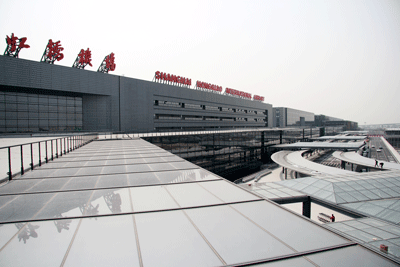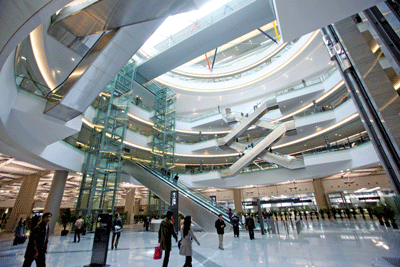Shanghai’s first civilian airport opened in Hongqiao, in the west of Puxi district, in the 1930s. So it was little surprise that 80 years later, the utilitarian terminal seemed outdated and undersized. Straining to operate at almost three times its intended capacity, and long since usurped as Shanghai’s premier airport by the 1999 opening and subsequent expansion of Pudong International Airport, Hongqiao Airport had become a byword for check-in chaos, terrible food and an impossibly long taxi queue.
Hongqiao’s developmental saviour would prove to be Shanghai’s projected capacity expansion, particularly during and after the 2010 World Expo. Shanghai remains, until Beijing’s second terminal opens in 2015, the only Chinese city with two international airports – and leading airlines are pressing for greater access. With Pudong already having opened a second terminal, the Hongqiao Airport Expansion Project was integrated into Shanghai’s multi-billion-dollar pre-Expo infrastructure upgrade.

Opened on March 16, the new US$2.2 billion Hongqiao Terminal 2 took five years to complete and occupies an area of 362,600sqm. It is the first part of the grandly titled Hongqiao Transport Hub that will serve as a multi-modal gateway to and from the Yangtze River Delta.
Hongqiao’s new terminal is more than treble the capacity of the old Terminal 1, with 45 boarding gates, 80 check-in counters and 47 security gates. It is targeted to handle 40 million passengers per year by 2015, largely thanks to a 3,300m-long second runway fitted with night-flying navigational systems. The dual runways enable Hongqiao to handle 45 landings and departures per hour, compared with the previous 33.
The spacious, airy terminal building encircles a central atrium stretched over seven levels from the basement subway station. The architecture is interwoven with huge windows and skylights, flyover bridges, glass elevators and bamboo courtyards.
A general criticism of Chinese airports is their lack of information and assistance, but here you can’t go 100m without seeing another information booth, staffed by puce-suited assistants that can answer questions in English. Another specific criticism of Hongqiao was its signage, but that has been improved since opening with ample Chinese and English visual directions.
The improvements are considerable. The sensible use of space, in particular, sets this new facility apart from the second terminal across the city in Pudong, which some have criticised as hastily and wastefully designed.
Checking in at the third floor Departures Hall is far less stressful than in the cramped Terminal 1. There are 80 well-spaced check-in counters and dedicated traveller channels while dozens of self-service boarding machines further streamline the process. Thirty-six group check-in counters at sections E and F currently cater to the myriad World Expo tour parties, while island D is reserved for China Eastern and Shanghai Airlines express flights to three major Chinese cities: Beijing, Guangzhou and Shenzhen.
Eleven domestic airlines, dominated by recently merged carriers China Eastern and Shanghai Airlines, operate from Terminal 2. The expanded capacity will be boosted next month, when 28 regular weekly services will connect Hongqiao with Hong Kong International Airport – a destination previously only reachable from Pudong airport.
Passengers transferring to Pudong International Airport across the Huangpu River in the far east of Shanghai can take advantage of a new cross-city check-in and baggage-drop service at island H. This is the first time such a service has been offered in Shanghai but only to passengers with international flights operated by China Eastern Airlines or its Shanghai Airlines affiliate that depart after 1pm from Pudong. And it is currently unavailable in the reverse direction.

The two-storey Meeters and Greeters’ Arrival Hall on level one enables loved ones or chauffeurs to spot new arrivals at the baggage concourse and proceed in an orderly fashion to the taxi queues and bus stops. Escalators and lifts zoom directly to the subway station. Roads lead out to the swirling flyovers of four elevated expressways linking the downtown suburbs in as little as 20 minutes on a good day. There is also plentiful car parking.
A convenient Left Baggage counter (from CNY15, or US$2.2, for four hours) and vending machines selling affordable mobile handsets with prepaid local SIM cards can also be found here.
Chinese airport dining, long monopolised by dreary state-concessioned diners – an issue that Pudong has still failed to address – has finally given way to the entry of global food chains. KFC and Taiwanese noodle shop Yonghe King do a roaring trade and offer comfortable booth seating at either end of the Arrival Hall.
Upstairs, you can get a decent cup of coffee at Gloria Jean’s, and a good gelato by rapidly expanding local brand, Iceseason. For something classier, wine and Greek mezze will be offered at a branch of Fat Olive, Australian chef David Laris’ popular Shanghai lounge. Through customs on the airside, there is a Starbucks and Subway among a pack of Chinese and Muslim cafés.
The huge billboards for Dior, Chanel, Prada and Zegna that look over the Departures Hall hint at the level of retail available through the gates at each side of the lounge areas – impressive considering that China does not offer a duty-free policy. Branded boutiques by Emporio Armani, Hermès, Ermenegildo Zegna, Coach and Dunhill can all be found here – this is consumer-conscious new China, after all.
A much-hyped highlight of the new terminal is the Chinese mainland’s first business aviation centre for private jets. This fast-growing mode of transport for China’s cash-rich, time-poor executives has seen business jet ownership triple on the mainland in the past five years and rapid expansion is predicted in the
next decade.
The CNY80 million (USD11.75 million) Hongqiao Airport Business Aviation Centre provides a full suite of services for privately owned aircraft, including leasing, hanger space and maintenance, plus conference and meeting rooms. Before its opening, official figures revealed that around 2,000 business aircraft took off or landed each year at Shanghai’s two airports. The new 6,000sqm hangar is expected to handle up to 6,000 business aircraft annually.
Probably the most impressive aspect of the new Terminal is its interconnectivity to the vast Hongqiao Integrated Hub. Covering 1.5 million sqm, this transport network connects the airport with Shanghai’s much expanded metro system, plus high-speed trains to and from neighbouring cities.
The Metro Line 2 (green) station, located in the basement of Terminal 2, conjoins both of Shanghai’s international airports via a two-hour subway ride – though it is currently operating on reduced testing hours and a train change is required at Guanglan Lu. A single fare to travel the full distance by metro line 2 costs CNY8 (US$1.18). Metro Line 10, soon to open at the adjacent Hongqiao Railway Station, links with popular downtown destinations such as Yu Gardens and Xintiandi.
For extra speed, travellers switching from Hongqiao to Pudong can alight at Longyang Lu station, and catch the eight-minute, 431kph Maglev train to complete the journey. Cross-city Maglev service that would link the two airports in 20 minutes has long been discussed, but the plan is yet to be approved.
The Hongqiao Transport Hub also boasts a railway station with 30 platforms for the 350kph intercity bullet trains travelling to and from the neighbouring cities of Nanjing and Hangzhou, and the 1,318km, five-hour Shanghai-Beijing express railway is slated to open in 2012.
Unfortunately, the only thing that isn’t easily accessible from Terminal 2 is Terminal 1. A 16-minute free shuttle bus is required to travel between them. The old terminal is reserved for budget airlines Spring and Eva Air plus some flights to South Korea, Japan and Songshan Airport in Taipei.
The new Hongqiao experience is generally smooth and swift – until you reach your airplane seat. China’s tightly controlled commercial air space often results in long delays at take-off and on our Saturday afternoon visit in mid-July, at least one-third of the departures board showed delayed flights. With ground-level services improving, China’s Civil Aviation must turn its efforts to an even greater challenge – reorganising the management of its skies.








